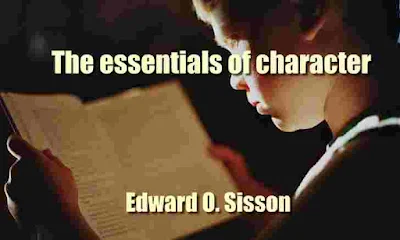The essentials of character
a practical study of the aim of moral education
Earnest men and women everywhere are deeply concerned in the development of character in the young, and many of them, especially parents and teachers, are actively engaged in moral training. This book has been written in the belief that a clear comprehension of what really makes up human character would be one of the first and best aids to the actual worker.
The whole plan and style of the work, including the selection of material, — and the omission of many things, — have been determined by this practical aim. This statement is not meant as an excuse for inaccuracy or fallacies, which I have endeavoured scrupulously to avoid.
The ruling idea in my own mind throughout, and I hope in the book, is what may be called the dynamic and organic nature of character: that character springs from native impulses and tendencies in the child, which are full of power, of push and thrust, and make themselves felt; out of these original tendencies, by organization and coordination, and by enlightenment, character arises, through gradual and often imperceptible processes. Moral education, then, must always strive to make connections with these sources of power by directing the im- pulses of nature into the service of human ideals.
On the other hand, I have tried to avoid the error of belittling the intellectual element in character: mere knowledge is doubtless impotent enough for moral ends, but ideas limited with emotional warmth and volitional power become ideals that dominate life, and the intellectual content is as essential to the ideal as the emotional warmth, for the ideal must contain the particular knowledge fitted to stir the heart and guide the conduct in the right direction. Moral education is generally recognized to be the most important of all educational questions, as well as the most complex and difficult.
The writer earnestly hopes that this little book may prove a modest help in the practical solution of the problem. It need hardly be added that criticism and suggestion will be received with sincere gratitude.
Some contents:
Introduction i
CHAPTER I
Native Tendencies S
Bodily activity. Sense-hunger and curiosity. Suggestibility. Tastes and appreciation. Self-assertion.
Love. Joy. Fear. The growing-up impulse. Love of approbation.
Love. Joy. Fear. The growing-up impulse. Love of approbation.
CHAPTER II
The Treatment of Native Tendencies .... 34
The Treatment of Native Tendencies .... 34
CHAPTER III
Disposition 44
Disposition 44
Cheerfulness. Kindness. Disposition and habit.
CHAPTER IV
Habits 60
The formation of habits. Obedience. Industry.
Thoughtfulness. Truthfulness. Bad habits.
Thoughtfulness. Truthfulness. Bad habits.
CHAPTER V
Tastes 94
Wholesome and inexpensive tastes. Food. Bodily
activity. Love of beauty. Good reading. Dangers in
aesthetic education.
activity. Love of beauty. Good reading. Dangers in
aesthetic education.
Download 4 MB
